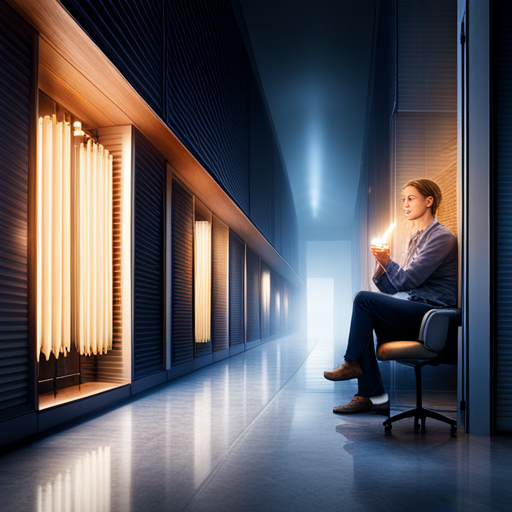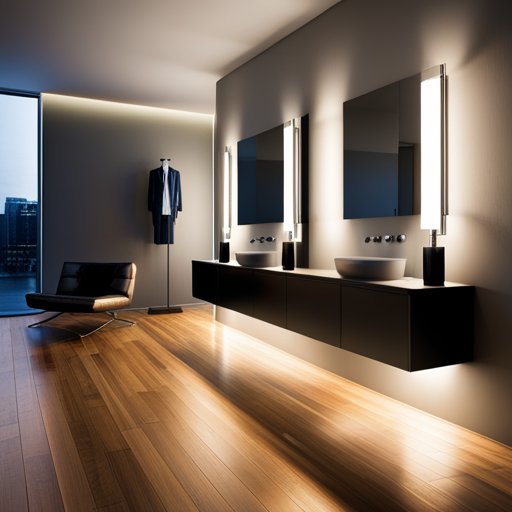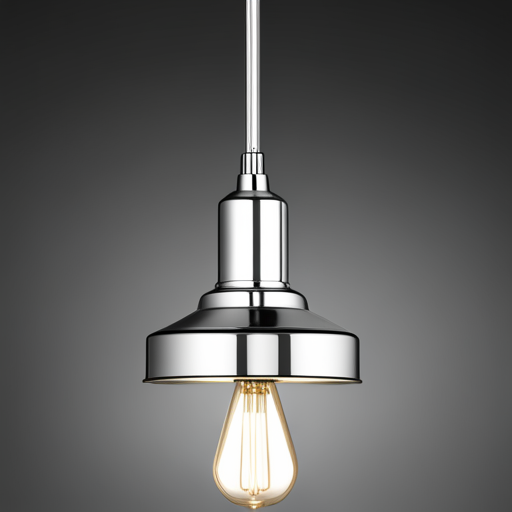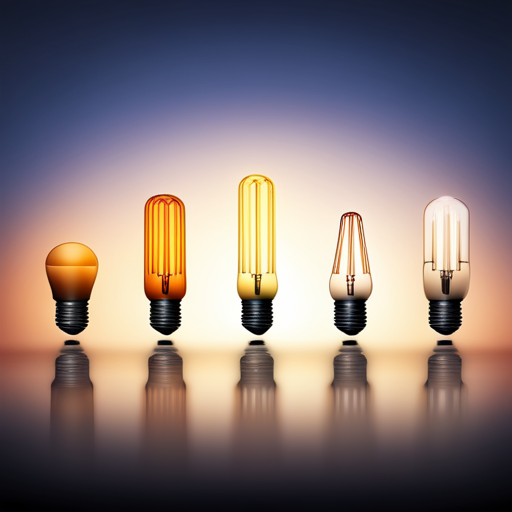By understanding this ratio, individuals can make informed decisions about light fixtures and enhance the overall efficiency of their lighting systems.
So, let’s dive in and uncover the secrets behind candle power per lumen!
Key Takeaways
– The lux unit is used to describe the brightness of light sources.
– To measure the brightness of a light bulb, divide the lumens rating by four to find out how many lux units it produces.
– Footcandles are another way to measure brightness and can be converted to lux units by multiplying by four.
– The radiant flux of a light source includes both non-visible and visible wavelengths, while the luminous flux refers to the visible-range wavelengths of electromagnetic energy emitted by a light source.
Definition of Candle Power and Lumen

https://www.youtube.com/watch?v=AcReybE6uGE
Candlepower is a measurement of the brightness of candlelight and is specifically used to determine the brightness of candlelight. It is measured in candelas, which quantifies the intensity of light emitted by a single candle.
On the other hand, lumens measure the overall amount of visible light emitted by a light source, regardless of the source’s brightness. It takes into account all visible wavelengths of light and provides a more comprehensive measurement of the light’s output.
Lumens are commonly used to compare the brightness of different light sources, such as light bulbs or LED lights. This allows consumers to make informed decisions when choosing lighting options.
Understanding the Relationship Between Candle Power and Lumen

The relationship between the intensity of light and the measurement of lumens can be understood by examining the correlation between the two variables. Here is a list of key points to help grasp this relationship:
1. Lumens measure the total amount of visible white light emitted by a light source.
2. Candlepower, also known as candelas, is used to determine the brightness of candlelight.
3. Lux is equal to the lumen output divided by the area illuminated.
4. Candlepower is another term for lux.
By understanding these concepts, one can better comprehend how the intensity of light is measured and how it relates to the measurement of lumens.
This knowledge is essential for various applications, such as determining the appropriate lighting levels for different environments or evaluating the efficiency of light sources.
Factors Affecting Candle Power per Lumen Ratio

Factors such as the light source’s efficiency, design, and materials used play a significant role in determining the candle power per lumen ratio.
The efficiency of a light source refers to how effectively it converts electrical energy into visible light. A more efficient light source will produce a higher candle power per lumen ratio.
The design of the light source also affects this ratio. Factors such as the shape and placement of the light-emitting elements can impact how the light is distributed and perceived.
Additionally, the materials used in the construction of the light source can influence its performance. For example, certain materials may have higher light transmission properties, resulting in a higher candle power per lumen ratio.
Overall, these factors contribute to the overall quality and effectiveness of the light source in terms of brightness and illumination.
Comparing Candle Power and Lumen in Different Light Sources

LED light bulbs have a higher brightness compared to incandescent light bulbs. This is due to their unique design and use of advanced technology. Here are four key reasons why LED light bulbs offer superior brightness:
1. Efficiency: LED bulbs convert a higher percentage of energy into light, resulting in a brighter output compared to incandescent bulbs.
2. Directionality: LED bulbs emit light in a specific direction, focusing the brightness where it is needed the most.
3. Color Temperature: LED bulbs can be manufactured to emit light at different color temperatures, allowing for customizable brightness levels.
4. Longevity: LED bulbs have a longer lifespan than incandescent bulbs, maintaining their brightness for a longer period of time.
Overall, LED light bulbs provide a brighter lighting solution with improved efficiency, directionality, color temperature options, and durability.
How to Calculate Candle Power per Lumen

Calculating candle power per lumen can be done by dividing the total candle power by the number of lumens emitted. This measurement is important in determining the efficiency of a light source and understanding how much light is produced per unit of power.
By dividing the candle power by the lumens, one can determine how bright a light source is relative to the amount of power it consumes. For example, if a light bulb has a candle power of 100 and emits 1000 lumens, the candle power per lumen would be 0.1. This means that for every lumen of light produced, the light bulb uses 0.1 candle power.
Calculating candle power per lumen allows for a more accurate comparison between different light sources and helps in making informed decisions about lighting choices.
Importance of Candle Power per Lumen in Lighting Design

Lighting designers consider the candle power per lumen measurement to determine the effectiveness and efficiency of different light sources. This measurement helps them understand how much light is produced per unit of power consumed.
Here’s why the candle power per lumen is important in lighting design:
1. Efficiency: By comparing the candle power per lumen of various light sources, designers can identify the most efficient options. Higher candle power per lumen values indicate that a light source is producing more light for the same amount of power.
2. Energy savings: Light sources with higher candle power per lumen require less energy to produce the same amount of light. This can lead to significant energy savings over time.
3. Quality of light: The candle power per lumen measurement also helps designers assess the quality of light produced by different sources. A higher value indicates better brightness and illumination.
4. Cost-effectiveness: By selecting light sources with higher candle power per lumen, designers can create lighting solutions that provide optimal brightness while minimizing energy costs.
Enhancing Candle Power per Lumen Ratio in Light Fixtures

Lighting designers are constantly striving to enhance the candle power per lumen ratio in light fixtures. By increasing this ratio, they can maximize the brightness and efficiency of the lighting system.
There are several ways to achieve this goal. First, designers can select light fixtures that have higher candle power ratings for a given lumen output. This means that the light fixture will produce a greater amount of light for the same amount of power consumed.
Additionally, designers can use reflective surfaces or lenses to focus and direct the light output, effectively increasing the candle power per lumen ratio.
Practical Applications of Candle Power per Lumen Ratio

Designers and engineers are constantly exploring practical applications for maximizing the brightness and efficiency of light fixtures by enhancing the candle power per lumen ratio. This ratio determines the amount of brightness generated by a light source for a given amount of power consumed. By increasing the candle power per lumen ratio, designers can create more efficient and powerful light fixtures.
The practical applications of this enhancement include:
1. Energy savings: Light fixtures with higher candle power per lumen ratios require less power to produce the same level of brightness, resulting in reduced energy consumption and lower electricity bills.
2. Increased visibility: Brighter light fixtures improve visibility in various settings such as outdoor areas, sports fields, and large indoor spaces, ensuring safety and enhancing visual experiences.
3. Extended lifespan: Light fixtures with higher candle power per lumen ratios tend to have longer lifespans, reducing maintenance and replacement costs.
4. Environmental impact: Efficient light fixtures with enhanced candle power per lumen ratios contribute to reducing greenhouse gas emissions and lowering environmental impact.
Overall, maximizing the candle power per lumen ratio in light fixtures offers numerous practical benefits in terms of energy efficiency, visibility, lifespan, and environmental sustainability.
Conclusion: Maximizing Efficiency With Candle Power per Lumen

Maximizing the candle power per lumen ratio in light fixtures results in increased energy efficiency and improved performance. By optimizing the amount of light produced for each lumen of energy consumed, light fixtures can provide brighter illumination while using less power.
This is achieved by using efficient light sources, such as LEDs, that convert a higher percentage of electrical energy into visible light. Additionally, the design and placement of light fixtures play a crucial role in maximizing the candle power per lumen ratio. By directing the light where it is needed and minimizing losses due to reflection or absorption, the overall efficiency of the lighting system can be improved.
This not only saves energy and reduces electricity bills but also enhances the quality of illumination, making spaces more visually appealing and functional.
Can Lumens Affect the Scent Intensity of Soy Candles?
Yes, lumens can affect the scent intensity of soy candles. Choosing the right wattage and lumen output for your lighting can help create the perfect ambiance for enjoying your strong scented soy candles recipe. Higher lumens can help to enhance the overall scent throw and atmosphere of your space.
Frequently Asked Questions
What Is the Difference Between Candle Power and Lumen?
Candle power and lumen measure different aspects of light. Candle power determines the brightness of candlelight, while lumen measures the total light output. Candle power is equivalent to lux, which is the lumen output divided by the illuminated area.
How Does the Candle Power per Lumen Ratio Affect the Efficiency of Light Fixtures?
The candle power per lumen ratio affects the efficiency of light fixtures. A higher ratio means that the fixture produces more light for a given amount of power, resulting in greater efficiency.
Are There Any Factors Other Than the Light Source That Can Affect the Candle Power per Lumen Ratio?
Factors such as the quality of the reflector, the efficiency of the light fixture, and the presence of any obstructions can affect the candle power per lumen ratio, in addition to the light source itself.
How Do You Calculate the Candle Power per Lumen for a Specific Light Fixture?
To calculate the candle power per lumen for a specific light fixture, divide the candle power by the lumen output. This ratio determines the brightness of the light produced by the fixture.
Can the Candle Power per Lumen Ratio Be Enhanced in Existing Light Fixtures, or Is It Only Applicable to New Designs?
The candle power per lumen ratio can be enhanced in existing light fixtures. It is not only applicable to new designs. Improved technology and modifications can increase the efficiency and brightness of the light output.

